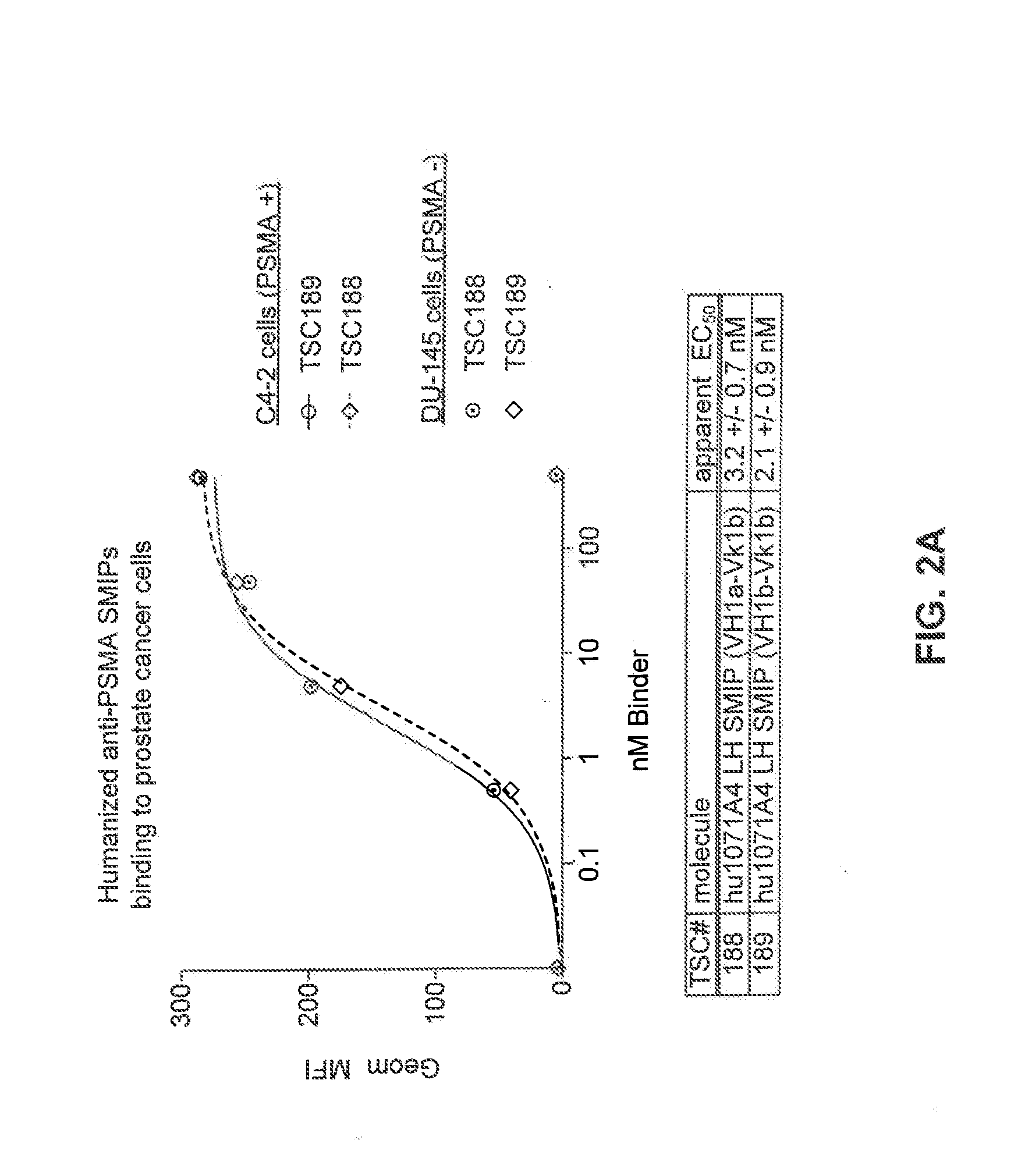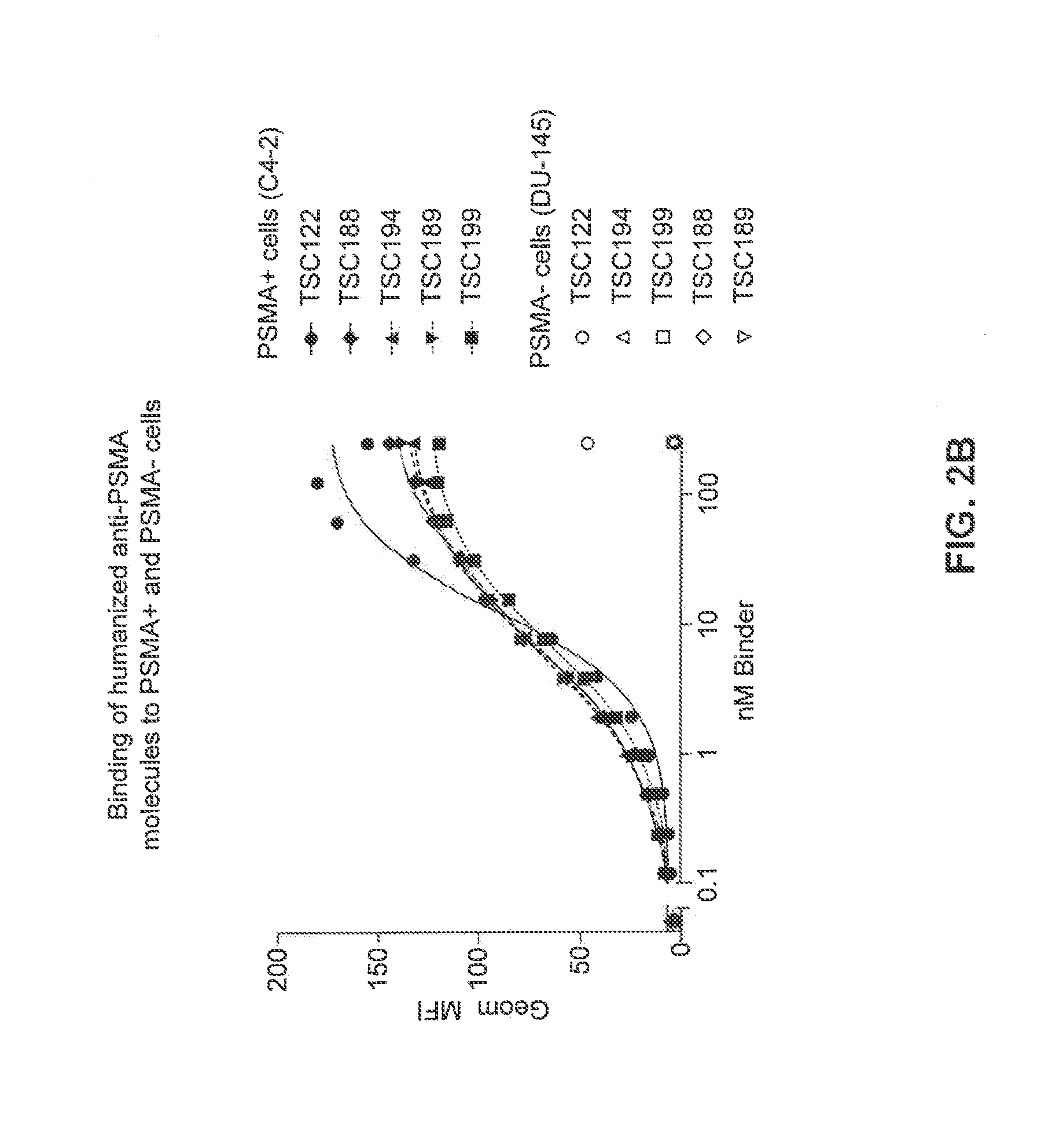Prostate-Specific Membrane Antigen Binding Proteins and Related Compositions and Methods
a membrane antigen and prostate-specific technology, applied in the field of prostate-specific membrane antigen binding proteins and related compositions, can solve the problems of low blood folate levels and consequent hyperhomocysteinemia, capromab may not be of therapeutic benefit, etc., to increase serum half-life, reduce internalization, and increase persistence time
- Summary
- Abstract
- Description
- Claims
- Application Information
AI Technical Summary
Benefits of technology
Problems solved by technology
Method used
Image
Examples
example 1
Isolation of Murine Variable Domains from 107-1A4 and Preparation of Humanized Variants
[0227]Murine variable domains were cloned from hybridoma cells expressing the 107-1A4 monoclonal antibody specific for human PSMA (see Brown et al, 1998, Prostate Cancer and Prostatic Diseases. 1: 208-215). Total RNA was isolated from the hybridoma using RNeasy® Protect Mini kit (QIAGEN Inc., 74124) according to the manufacturer's instructions. SMART™ RACE cDNA amplification kit (Clontech Laboratories, Inc., 634914) was used to generate 5′RACE-ready cDNA with oligo(dT) primer according to the manufacturer's instructions. VH and VL regions of antibody were PCR-amplified from cDNA by SMART™ RACE protocol using pools of proprietary degenerate gene specific primers for different murine VK or VH gene families. PCR amplification products were confirmed by gel electrophoresis, and correct sized bands were isolated and cloned into pCR®2.1-TOPO® plasmid vector using the TOPO® TA Cloning kit according to ma...
example 2
Heterodimeric Molecules
[0231]PSMA-specific Interceptor molecules were made using Interceptor scaffolding as generally disclosed in International Appl. Nos. PCT / US2010 / 62436 and PCT / US2010 / 62404. Briefly, PSMA-specific polypeptide heterodimers were made by co-expressing two different polypeptides chains, one polypeptide chain comprising an immunoglobulin CH1 heterodimerization domain and the other polypeptide chain comprising an immunoglobulin CL heterodimerization domain. The day before transfection HEK293 cells were suspended at a cell concentration of 0.5×106 cells / ml in GIBCO® FreeStyle™ 293 expression medium (Invitrogen). 250 mls of cells were used for a large transfection, and 60 mls of cells were used for a small transfection. On transfection day, 320 ul of 293Fectin™ transfectin reagent (Invitrogen) was mixed with 8 mls of media. At the same time, 250 ug of DNA of each of the single chain polypeptide was mixed with the 8 mls of media and incubated for 5 minutes. After 15 minu...
example 3
SCORPION Molecule Construction
[0239]PSMA-specific SCORPION molecules (TSC194 (SEQ ID NO:48 (nucleic acid), SEQ ID NO:49 (amino acid); TSC199 (SEQ ID NO:50 (nucleic acid), SEQ ID NO:51 (amino acid)); TSC 212 (SEQ ID NO:73 (nucleic acid), SEQ ID NO:74 (amino acid)); TSC213 (SEQ ID NO:75 (nucleic acid), SEQ ID NO:76 (amino acid)); TSC249 (SEQ ID NO:77 (nucleic acid), SEQ ID NO:78 (amino acid)); TSC250 (SEQ ID NO:79 (nucleic acid), SEQ ID NO:80 (amino acid)); TSC251 (SEQ ID NO:81 (nucleic acid), SEQ ID NO:82 (amino acid)); and TSC252 (SEQ ID NO:83 (nucleic acid), SEQ ID NO:84 (amino acid))) were made using standard molecular biology techniques, starting with existing SCORPION scaffolding as templates and using the methods generally disclosed in, e.g., PCT Application Publication No. WO 2007 / 146968, U.S. Patent Application Publication No. 2006 / 0051844, PCT Application Publication No. WO 2010 / 040105, PCT Application Publication No. WO 2010 / 003108, and U.S. Pat. No. 7,166,707 (see also Tab...
PUM
| Property | Measurement | Unit |
|---|---|---|
| nucleic acid | aaaaa | aaaaa |
Abstract
Description
Claims
Application Information
 Login to View More
Login to View More - R&D
- Intellectual Property
- Life Sciences
- Materials
- Tech Scout
- Unparalleled Data Quality
- Higher Quality Content
- 60% Fewer Hallucinations
Browse by: Latest US Patents, China's latest patents, Technical Efficacy Thesaurus, Application Domain, Technology Topic, Popular Technical Reports.
© 2025 PatSnap. All rights reserved.Legal|Privacy policy|Modern Slavery Act Transparency Statement|Sitemap|About US| Contact US: help@patsnap.com



